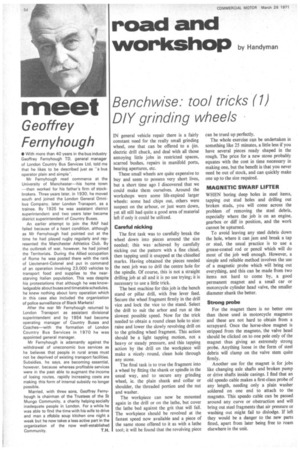road and
Page 56

If you've noticed an error in this article please click here to report it so we can fix it.
workshop by Handyman
Benchwise: tool tricks (1) DIY grinding wheels
IN general vehicle repair there is a fairly constant need for the really small grinding wheel, one that can be offered to a +in. electric drill chuck, and deal with all those annoying little jobs in restricted spaces, scarred bushes, repairs in manifold ports, bearing apertures, etc.
These small wheels are quite expensive to buy and seem to possess very short lives, but a short time ago I discovered that we could make them ourselves. Around the workshops were some life-expired larger wheels: some had chips out, others were suspect on the arbour, or just worn down, yet Ml still had quite a good area of material left if only it could be utilized.
Careful nicking The first task was to carefully break the wheel down into pieces around the size needed; this was achieved by carefully nicking out the pattern with a fine chisel, then tapping until it snapped at the chiselled marks. Having obtained the pieces needed the next job was to drill the centre hole for the spindle. Of course, this is not a straight drilling job at all and it is po use trying; it is necessary to use a little trick.
The best machine for this job is the bench stand or pillar drill, with free lever feed. Secure the wheel fragment firmly in the drill vice and lock the vice to the stand. Select the drill to suit the arbor and run at the slowest possible speed. Now for the trick needed to obtain a round clean hole to size: raise and lower the slowly revolving drill on to the grinding wheel fragment. This action should be a light tapping motion, not a heavy or steady pressure, and this tapping action by the drill on the workpiece will make a nicely. round, clean hole through any stone.
The final task is to true the fragment into a wheel by fitting the shank or spindle in the usual way, and to secure any grinding wheel, ie. the plain shank and collar or shoulder, the threaded portion and the nut and washer.
The workpiece can now be mounted again in the drill or on the lathe, but cover the lathe bed against the grit that will fall. The workpiece should be revolved at the fastest speed now available and a piece of the same stone offered to it as with a lathe tool; it will be found that the revolving piece can be trued up perfectly.
The whole exercise can be undertaken in something like 25 minutes, a little less if you have several pieces ready shaped in the rough. The price for a new stone probably equates with the cost in time necessary in making one, but the benefit is that you never need be out of stock, and can quickly make one up to the size required.
MAGNETIC SWARF LIFTER WHEN boring deep holes in steel items, tapping out stud holes and drilling out broken studs, you will come across the problem of removing the steel debris, especially where the job is on an engine, gearbox or dill' in position, and the work cannot be upturned.
To avoid leaving any steel debris down the hole, where it can jam and break a tap or stud, the usual practice is to use a grease-coated rod or pencil which will do most of the job well enough. However, a simple and reliable method involves the use of a magnetic probe which will bring out everything, and this can be made from two items not hard to come by, a good permanent magnet and a small car or motorcycle cylinder head valve, the smaller diameter shank the better.
Strong probe For the magnet there is no better one than those used in motorcycle magnetos and these are not hard to obtain from a scrapyard. Once the horse-shoe magnet is stripped from the magneto, the valve head should be clicked on to one pole only of the magnet thus giving an extremely strong probe. Anything loose in the form of steel debris will clamp on the valve stern quite firmly.
Another use for the magnet is for jobs like changing axle shafts and broken pump or drive shafts inside casings. I find that an old speedo cable makes a first-class probe of any length, needing only a plain washer soldered on one end to attach to the magneto. This speedo cable can be passed around any curve or obstruction and will bring out steel fragments that air pressure or washing out might fail to dislodge. If left they would be a danger to the new parts fitted, apart from later being free to roam elsewhere in the unit.














































































































